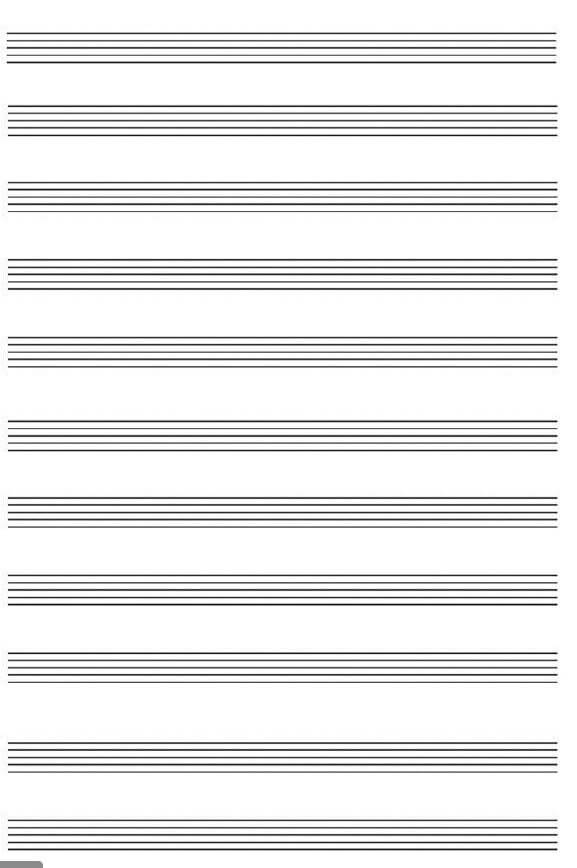MUSIC GRADE 12 PAPER 1 QUESTIONS - NSC PAST PAPERS AND MEMOS SEPTEMBER 2017
Share via Whatsapp Join our WhatsApp Group Join our Telegram GroupMUSIC
GRADE 12
PAPER 1
NSC PAST PAPERS AND MEMOS
SEPTEMBER 2017
INSTRUCTIONS AND INFORMATION
- This question paper consists of FIVE sections, namely SECTIONS A, B, C, D and E.
- SECTIONS A and B are COMPULSORY.
- SECTION C: WESTERN ART MUSIC (WAM), SECTION D: JAZZ and SECTION E: INDIGENOUS AFRICAN MUSIC (IAM) are choice questions.
Answer only ONE of these sections (SECTION C or D or E) - Write all music notation in SECTION A in pencil and all written text in blue or black ink. Answer in the spaces provided on this question paper.
- Answer SECTION B and SECTION C or D or E in blue or black ink in the ANSWER BOOK provided.
- Number the answers correctly according to the numbering system used in this question paper.
- The last page of this question paper is manuscript paper intended for rough work. It may be removed by the candidate.
- Use the table on the next page as a guide for mark and time allocation when answering each question.
- Write neatly and legibly.
MARKING GRID
SECTION | QUESTION | MARKS | MARKER | MODERATOR |
A: THEORY OF MUSIC (COMPULSORY) | 1 | 20 | ||
2 | 15 | |||
3 | 10 | |||
4 | 15 | |||
SUBTOTAL | 60 | |||
AND | ||||
B: GENERAL MUSIC KNOWLEDGE (COMPULSORY) | 5 | 20 | ||
SUBTOTAL | 20 | |||
AND | ||||
C: WAM | 6 | 10 | ||
7 | 5 | |||
8 | 5 | |||
9 | 5 | |||
10 | 15 | |||
SUBTOTAL | 40 | |||
OR | ||||
D: JAZZ | 11 | 10 | ||
12 | 5 | |||
13 | 5 | |||
14 | 5 | |||
15 | 15 | |||
SUBTOTAL | 40 | |||
OR | ||||
E: IAM | 16 | 10 | ||
17 | 5 | |||
18 | 5 | |||
19 | 5 | |||
20 | 15 | |||
SUBTOTAL | 40 | |||
GRAND TOTAL | 120 | |||
QUESTIONS
SECTION A: THEORY OF MUSIC (COMPULSORY) (90 minutes)
Answer QUESTION 1
AND QUESTION 2.1 OR 2.2
AND QUESTION 3.1 OR 3.2
AND QUESTION 4.1 OR 4.2
Answer all the questions in the spaces provided on this question paper.
1. Study the Prelude from Op.28. No. 4 by Chopin below and answer the questions that follow.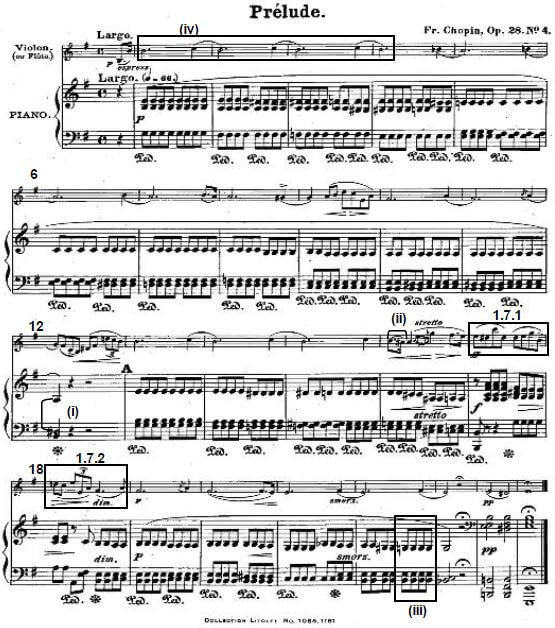
1.1 Name the relative key of the piece. (1)
1.2 What does the abbreviation “Op.” stand for? (1)
1.3 Give the English meaning for the term “Largo”. (1)
1.4 Identify the intervals marked (i) and (ii) complete according to type and distance.
- (2)
1.5 Invert the interval at (i) and write its correct description underneath it.
Answer: (2)
1.6 Name the triad marked (iii) according to type and inversion. Re-write it in root position, using semibreves.
(iii)(3)
1.7
1.7.1 Transpose the violin part of bar 17 for Clarinet in B-flat. Insert the new key signature.  (2)
(2)
1.7.2 Rewrite the violin part of bar 18 in double the note values. Insert the new time signature.  (3)
(3)
1.8 Identify the compositional technique used to change (iv). (1)
Doubling | Diminution | Inversion |
1.9
1.9.1 Write the E Blues scale ascending, without key signature, in the tenor clef.
 (2)
(2)
1.9. 2 Write the G wholetone scale descending in the alto clef. (2)
(2)
[20]
QUESTION 2 (25 minutes)
ANSWER EITHER QUESTION 2.1 OR QUESTION 2.2.
2.1 Using the opening motif, complete a twelve-bar melody in ternary form for any single line melodic instrument of your choice. Indicate the instrument for which you are writing, adding dynamics, tempo indication and articulation marks.
Instrument: _______________________________
Tempo: _______________________________
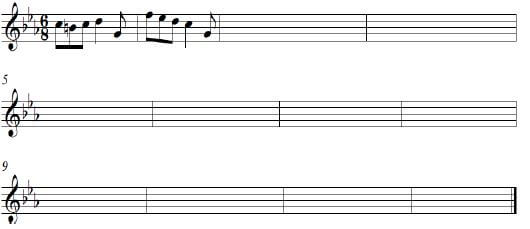
The melody will be marked according to the criteria below:
DESCRIPTION | MARK ALLOCATION | CANDIDATE’S MARK |
Form and cadential points | 3 | |
Correctness | 2 | |
Quality | 10 | |
TOTAL | 15 |
[15]
OR
2.2 Use the opening motif below to complete a twelve-bar melody in ternary form for any single-line melodic instrument of your choice. Indicate the instrument for which you are writing and add dynamic and articulation marks.
Instrument: _______________________________
Tempo: _______________________________

The melody will be marked according to the criteria below:
DESCRIPTION | MARK ALLOCATION | CANDIDATE’S MARK |
Form and cadential points | 3 | |
Correctness | 2 | |
Quality | 10 | |
TOTAL | 15 |
[15]
QUESTION 3 (10 minutes) ANSWER QUESTION 3.1 OR QUESTION 3.2.
3.1 Study the extract Der Span auf den Wellen from Op. 17 No. 7 by Jean Sibelius below and answer the questions that follow. 
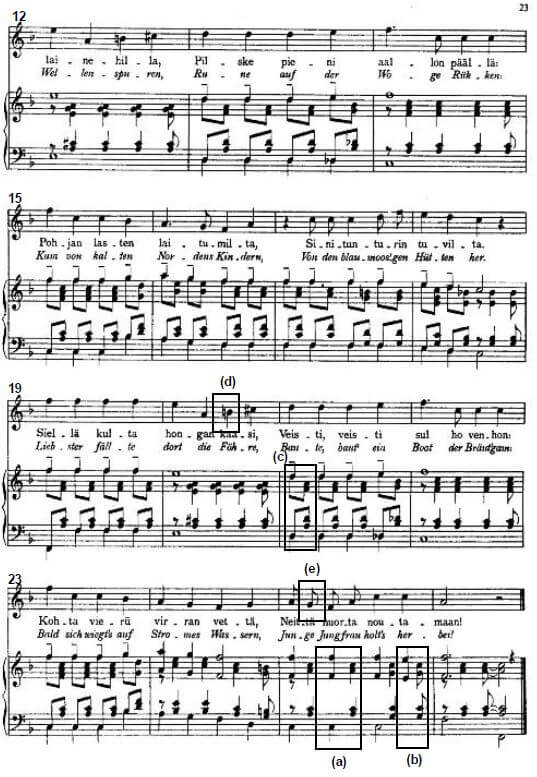
3.1.1 Name the key of the first section of the piece. (1)
3.1.2 Name the relative key of the second section of the piece. (1)
3.1.3 Identify the cadence on which the piece ends and write the chords of the cadence, e.g. Interrupted cadence: V – VI. (2)
3.1.4 Choose the correct answer for the compositional technique that appears regularly in the melody. (1)
Repetition | Sequence | Inversion |
3.1.5 Figure the chords at (a), (b) and (c) complete using Roman numbers, e.g. G: V (or Va) OR chord symbols, e.g. D.
- _______________________________ (1)
- _______________________________ (1)
- _______________________________ (1)
3.1.6 Name the type of non-chordal notes at (d) and (e):
d. _______________________________ (1)
e. _______________________________ (1)
[10]
OR
3.2 Study the extract below from 15 Easy Pieces for Piano by D. Valeras and answer the questions. 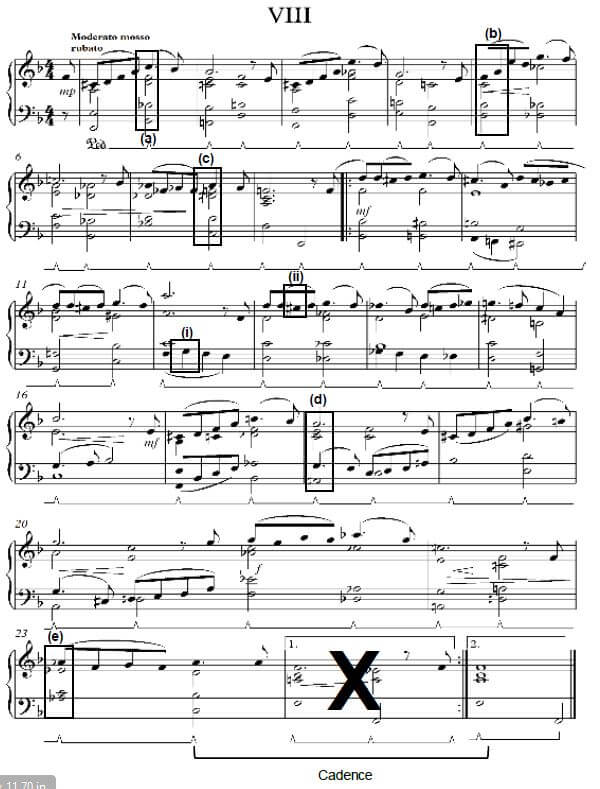
3.2.1 Name the key of the piece. (1)
3.2.2 Identify the chords (a) to (e) and number them correctly below. Use chord symbols, e.g. C/E.
- _______________________________
- _______________________________
- _______________________________
- _______________________________
- (5)
3.2.3 Name the type of non-chordal notes at (i) and (ii).
- _______________________________
- _______________________________ (2)
3.2.4 Name the cadence at the end of the piece. Identify the cadence by adding the correct chord symbols.
Cadence: _______________________________
Chord symbols: _______________________________(2)
[10]
QUESTION 4 (30 minutes)
Answer QUESTION 4.1 OR QUESTION 4.2.
4.1 Complete the four-part vocal harmonisation below by adding the alto, tenor and bass parts. Use at least ONE non-chordal note in the added parts. 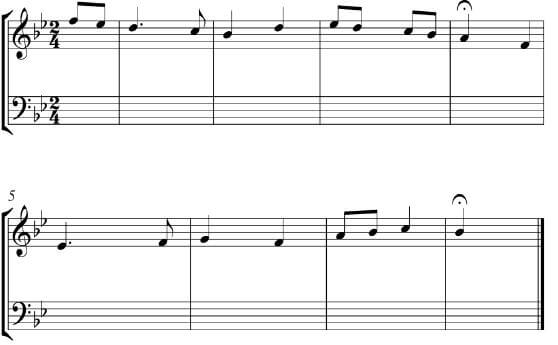
The harmonisation will be marked according to the criteria below:
DESCRIPTION | MARK ALLOCATION | CANDIDATE’S MARK |
Chord progression | 14 | |
Correctness | 16 (Minus ½ mark per mistake) | |
Quality | 10 | |
40 (÷ 8 x 3) | ||
TOTAL | 15 |
[15]
OR
4.2 Complete the piece below by adding suitable harmonic material in the bass clef. Ensure that you continue to write in the given style. 
The harmonisation will be marked according to the criteria below:
DESCRIPTION | MARK ALLOCATION | CANDIDATE’S MARK |
Chord progression | 15 | |
Correctness | 15 | |
Quality | 10 | |
40 (÷ 8 x 3) | ||
TOTAL | 15 |
[15]
TOTAL SECTION A: 60
SECTIONS B, C, D, E: GENERAL MUSIC KNOWLEDGE (90 minutes)
Answer SECTION B
AND SECTION C (Western Art Music)
OR SECTION D (Jazz)
OR SECTION E (Indigenous African Music)
Answer these in the ANSWER BOOK provided.
SECTION B: GENERAL KNOWLEDGE (COMPULSORY)
QUESTION 5
5.1 Four options are provided as possible answers to the following questions. Choose the correct answer and write only the letter (A–D) next to the question number in the ANSWER BOOK, e.g. 5.1.11 E.
5.1.1 Which ONE of the following is NOT an element of music?
- Form
- Melody
- Functional music
- Harmony (1)
5.1.2 Which ONE of the following does not form part of African music?
- Homophony
- Call and refrain
- Overlapping
- Mixed selection (1)
5.1.3 Smorzando means …
- gradually faster.
- gradually slower.
- dying away/fading away.
- very loud. (1)
5.1.4 Which ONE of the following does not fit as an example of sound production?
- Aerophone
- Chordophone
- Membranophone
- Percussion (1)
5.1.5 Which style of music does not fit into the 20th century’s style of music?
- Expressionism
- Atonal music
- Impressionism
- Moppies and Ghoema (1)
5.1.6 A duplet is …
- two notes played in the time of three.
- three notes played in the time of two.
- five notes played in the time of three or four.
- seven notes played in the time of four or six. (1)
5.1.7 Which ONE refers to Rondo form?
- AB
- ABA
- ABCD
- ABACA Coda (1)
5.1.8 The natural minor is also known as … mode.
- Locrian
- Aeolian
- Phrygian
- Ionian (1)
5.1.9 When a piece is composed in a minor key and ends on the final chord as major, this phenomenon is called ONE of the following:
- Ornamentation
- Modulation
- Tierce di Picardi
- Inversion (1)
5.1.10 A saxophone is a … instrument.
- percussion
- woodwind
- brass
- string (1)
5.2 Answer the following questions.
5.2.1 Describe shortly what the music industry entails. (1)
5.2.2 Define needletime rights. (1)
5.2.3 Give a short description on how music royalties work. (2)
5.2.4 How many years must lapse after the death of a composer, for his/her works to become public domain, unless the copyright is renewed by family? (1)
5.3 Give the Italian term for the following description:
5.3.1 To play a specific passage of music with fire and vehement energy. (1)
5.4 Name TWO very specific style characteristics of the music of Beethoven. (2)
5.5 Describe the difference between Sonata and Sonata Form. (2)
TOTAL SECTION B: 20
Answer SECTION C (WAM)
OR SECTION D (JAZZ)
OR SECTION E (IAM).
QUESTION 6
6.1 Define the following:
6.1.1 Grand opera (2)
6.1.2 The development of instrumentation in the Romantic era. (2)
6.1.3 Alberti bass (1)
6.2 What is the significance of the number three in Mozart’s opera, Die Zauberflöte? (1)
6.3 Name TWO examples which feature the number three in Die Zauberflöte. (2)
6.4 Describe ONE technique used to change the theme when composing in Theme and Variation style. (1)
6.5 Why is Beethoven’s Symphony No. 6 Opus 68 in F major different to other symphonies? (1)
[10]
QUESTION 7
7.1 Name THREE characteristics of the opera music of the Florentine Camerata. (3)
7.2 One of the most important opera composers was Monteverdi. Explain the meaning of this statement. (2) [5]
QUESTION 8
Compare Singspiel with Music Drama. Name TWO differences and ONE similarity regarding the style types. (5) [5]
QUESTION 9
Write a short description about the significant elements of the second theme of “Fingal’s Cave” regarding the instrumentation. (5) [5]
QUESTION 10
Write an extensive article for your school newspaper regarding the FOURTH and FIFTH movements of Beethoven’s Symphony No. 6, opus 68. Discuss, amongst other facts, the use of the instruments to show the events taking place in nature.
You will be credited for the logical presentation of facts and the structure of your essay. (15)
[15]
TOTAL SECTION C: 40
OR
SECTION D: JAZZ
QUESTION 11
11.1 Choose the correct answer from COLUMN B to match the statement/name in COLUMN A. Write only the correct matching letter (A–F) next to the question number (11.1.1–11.1.6) in the ANSWER BOOK, e.g. 11.1.7 G.
| COLUMN A | COLUMN B |
11.1.1 Kwela |
|
(6 x 1) (6)
11.2 Name TWO similarities between Mbaqanga and Marabi. (2)
11.3 With which instrument is Marabi associated? (1)
11.4 The Merry Blackbirds enjoyed playing the music of American ragtime, as well as written jazz arrangements. Name ONE artist whose arrangements they played. (1)
[10]
QUESTION 12
12.1 Write a paragraph, describing the Marabi style of The Jazz Maniacs and their influence and contribution of Solomon Cele in the development of the style. (3)
12.2 Describe New Jazz in a short paragraph and name ONE important artist of this style. (2) [5]
QUESTION 13
What was the origin of Kwela music? How did Kwela influence the music scene in South Africa? (5) [5]
QUESTION 14
How did Jazz in exile influence the development of the music of South African musicians? (5) [5]
QUESTION 15
Write a comprehensive essay on the music of ONE of the following South African artists:
- Miriam Makeba
- Josephine ‘Dolly’ Rathebe
- Thandi Klaassen
You will be credited for the logical presentation of facts and the structure of your essay.
The essay will be marked according to the following criteria:
CRITERIA | MARK ALLOCATION |
Music characteristics | 5 |
Origins and Influence | 5 |
Albums/Songs | 2 |
Logical presentation and structure of the essay | 3 |
TOTAL | 15 |
[15]
TOTAL SECTION D: 40
OR
SECTION E: INDIGENUOUS AFRICAN MUSIC (IAM)
QUESTION 16
16.1 Choose the correct answer from COLUMN B to match the item in COLUMN A. Write only the correct matching letter (A–F) next to the question number (16.1.1–16.1.5) in the ANSWER BOOK, e.g. 16.1.6 F.
| COLUMN A | COLUMN B |
16.1.1 Indlamu dance |
|
(5 x 1) (5)
16.2 What was the origin of the word “mbaqanga” and the symbolic meaning of it under musicians? (2)
16.3 From which word is “Maskandi/Maskanda” derived? (1)
16.4 Explain the goal of Isicathamiya. (1)
16.5 What is the nickname of Philip Tabane? (1) [10]
QUESTION 17
The saxophonist of the Makgona Tsohle Band, West Nkosi, played a different instrument and a different style at the start of his music career. Name the instrument and style. Also describe his path in music until 1963 when he and his band were stranded in Northern Rhodesia for 6 months. (5)
[5]
QUESTION 18
Discuss the elements of music used by The Cool Crooners as part of their mix of Mbaqanga, as well as a short overview about the group. (5) [5]
QUESTION 19
19.1 There are two specific musical styles and structures in Maskandi/ Maskanda music. The first is Izihlabo. Identify and describe the second style and its characteristics. (3)
19.2 How was the original Kiba style of music style changed to Free Kiba? (2) [5]
QUESTION 20
Isicathamiya is one of the oldest South African choir styles. Write a comprehensive essay on Isicathamiya, explaining this statement.
You will be credited for the logical presentation of facts and the structure of your essay.
The essay will be marked according to the following criteria:
CRITERIA | MARK ALLOCATION |
Origins | 4 |
Style characteristics | 6 |
Artist and song | 2 |
Logical presentation and structure of the essay | 3 |
TOTAL | 15 |
[15]
TOTAL SECTION E: 40
GRAND TOTAL: 120
